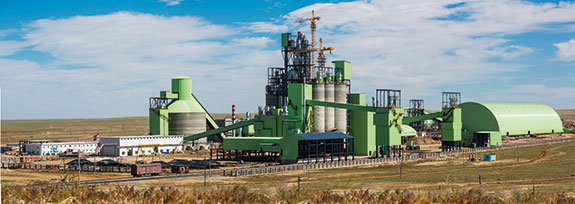Moncement Plant Tour – Part 1
Building a greenfield cement plant in any location is not without its challenges. Building a greenfield cement plant in the Gobi Desert, Mongolia, where there is a lack of both water and infrastructure, is more challenging still. But Mongolian mining and construction company, Monpolymet Group, took on this challenge and in August 2015 its subsidiary company Moncement Building Materials began commissioning at the Senj Sant plant.

Background and financing
Initial work on the project began in 2008 with the first limestone mine exploration and permits. Much of the preliminary research had already been undertaken by the time the European Bank for Reconstruction and Development (EBRD) came on as a major investor in the project in May 2013. The EBRD was attracted not only by the need for investment in the region and the plans for the plant to utilise the best available technology, but also by the fact that Moncement is led by a strong female team with a high environmental and social consciousness, and a strong sense of responsibility and integrity. A further loan agreement was signed in April 2014, which covers 50% of the debt. The remaining 50% was financed by the Development Bank of Mongolia.
The EBRD is currently the largest financial investor in Mongolia, with over e1.1 billion invested to date. About 9% of these investments have gone to companies operating in the building materials sector, and almost all the investments support private sector companies and banks. The EBRD is focused on supporting projects that foster growth and innovation and promote a country’s transition to market economies.
Mongolia’s cement industry
In 2014, cement consumption in Mongolia reached around 2 million t, equivalent to a per capita consumption of 650 kg. As much of 80% of this was imported from China, as Mongolia had just one significant cement operation. The main market for cement is Ulaanbaatar, where increasing urbanisation is spurring on housing construction. From 2016 onwards, important public projects and foreign investments are planned that will increase cement demand, while new entrants such as Moncement are joining the market and will, over the next five years or so, be able to meet all of the country’s needs, putting an end to imports.
In addition to the new cement plant, Moncement has also started work on a new cement terminal in Ulaanbaatar, which is expected to be completed in 3Q16. The two projects together will give a total capacity of 1 million tpy of cement, enough to provide 30 – 40% of the anticipated market demand in 2016. An additional production line is also planned at the plant, though the timing of this second phase has not yet been announced.
Choosing the location
The location of the plant in Orgun Soum was chosen based on the availability of limestone reserves and its accessibility to Ulaanbaatar (540 km away) and Sainshand via a direct rail connection situated close by. An extension linking the existing railway with the plant was built as part of the project. Two sites were looked at in Orgun, but ultimately the Senj Sant site was chosen for logistic and environmental reasons, being downwind of the existing village, which should reduce the potential impact of the plant on the local community.
This is part three of a three-part article written by Katherine Guenioui for World Cement’s January 2016 issue and abridged for the website. Subscribers can read the full issue by signing in, and can also catch up on-the-go via our new app for Apple and Android. Check back tomorrow for part two of the article on www.worldcement.com.
Read the article online at: https://www.worldcement.com/special-reports/14012016/moncement-plant-tour-1/
You might also like
World Cement Spotlight with Innomotics
Senior Editor of World Cement, David Bizley, is joined by Sunny Schoone of Innomotics for a World Cement Spotlight Interview.



